Critical Analysis of Indigenous Stories in Political Science, Canada
VerifiedAdded on 2022/08/28
|8
|2127
|30
Essay
AI Summary
This essay provides a critical analysis of the book "Read, Listen, Tell: Indigenous Stories from Turtle Island," examining its contribution to Indigenous literature and political science. The essay explores the themes of land, language, and community, highlighting the diversity and depth of Indigenous writing. It discusses the book's significance in showcasing Indigenous perspectives and experiences, emphasizing the importance of storytelling in reintroducing and firming community connections. The analysis covers the book's structure, themes, and methodologies, including its use of genre fictions and oral storytelling methods. The essay also examines the impact of colonization on Indigenous languages and cultures, the importance of Indigenous knowledge, and the book's role in expanding critical thinking and global citizenship. The conclusion emphasizes the book's value for literary studies and Indigenous studies courses.
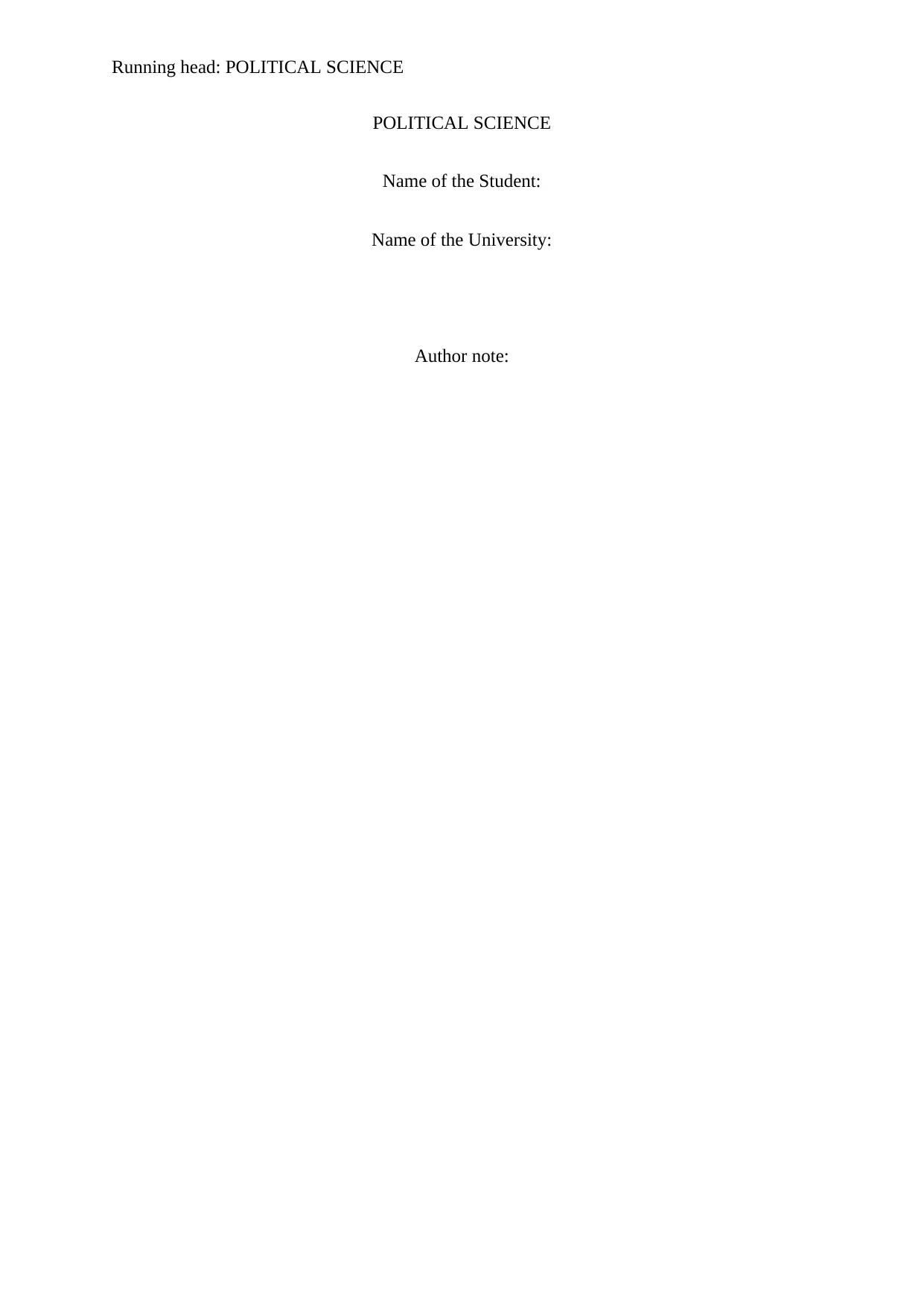
Running head: POLITICAL SCIENCE
POLITICAL SCIENCE
Name of the Student:
Name of the University:
Author note:
POLITICAL SCIENCE
Name of the Student:
Name of the University:
Author note:
Paraphrase This Document
Need a fresh take? Get an instant paraphrase of this document with our AI Paraphraser
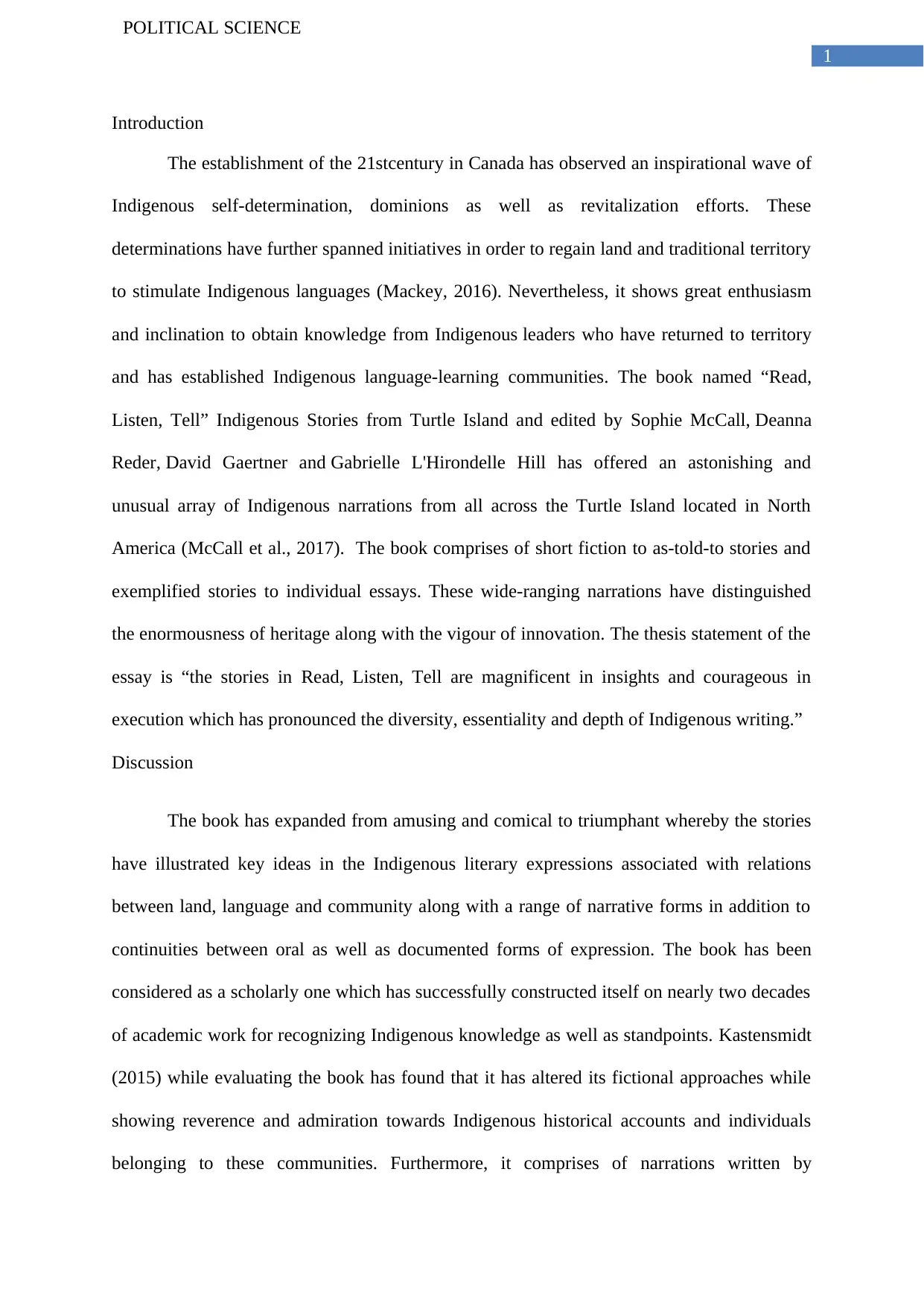
1
POLITICAL SCIENCE
Introduction
The establishment of the 21stcentury in Canada has observed an inspirational wave of
Indigenous self-determination, dominions as well as revitalization efforts. These
determinations have further spanned initiatives in order to regain land and traditional territory
to stimulate Indigenous languages (Mackey, 2016). Nevertheless, it shows great enthusiasm
and inclination to obtain knowledge from Indigenous leaders who have returned to territory
and has established Indigenous language-learning communities. The book named “Read,
Listen, Tell” Indigenous Stories from Turtle Island and edited by Sophie McCall, Deanna
Reder, David Gaertner and Gabrielle L'Hirondelle Hill has offered an astonishing and
unusual array of Indigenous narrations from all across the Turtle Island located in North
America (McCall et al., 2017). The book comprises of short fiction to as-told-to stories and
exemplified stories to individual essays. These wide-ranging narrations have distinguished
the enormousness of heritage along with the vigour of innovation. The thesis statement of the
essay is “the stories in Read, Listen, Tell are magnificent in insights and courageous in
execution which has pronounced the diversity, essentiality and depth of Indigenous writing.”
Discussion
The book has expanded from amusing and comical to triumphant whereby the stories
have illustrated key ideas in the Indigenous literary expressions associated with relations
between land, language and community along with a range of narrative forms in addition to
continuities between oral as well as documented forms of expression. The book has been
considered as a scholarly one which has successfully constructed itself on nearly two decades
of academic work for recognizing Indigenous knowledge as well as standpoints. Kastensmidt
(2015) while evaluating the book has found that it has altered its fictional approaches while
showing reverence and admiration towards Indigenous historical accounts and individuals
belonging to these communities. Furthermore, it comprises of narrations written by
POLITICAL SCIENCE
Introduction
The establishment of the 21stcentury in Canada has observed an inspirational wave of
Indigenous self-determination, dominions as well as revitalization efforts. These
determinations have further spanned initiatives in order to regain land and traditional territory
to stimulate Indigenous languages (Mackey, 2016). Nevertheless, it shows great enthusiasm
and inclination to obtain knowledge from Indigenous leaders who have returned to territory
and has established Indigenous language-learning communities. The book named “Read,
Listen, Tell” Indigenous Stories from Turtle Island and edited by Sophie McCall, Deanna
Reder, David Gaertner and Gabrielle L'Hirondelle Hill has offered an astonishing and
unusual array of Indigenous narrations from all across the Turtle Island located in North
America (McCall et al., 2017). The book comprises of short fiction to as-told-to stories and
exemplified stories to individual essays. These wide-ranging narrations have distinguished
the enormousness of heritage along with the vigour of innovation. The thesis statement of the
essay is “the stories in Read, Listen, Tell are magnificent in insights and courageous in
execution which has pronounced the diversity, essentiality and depth of Indigenous writing.”
Discussion
The book has expanded from amusing and comical to triumphant whereby the stories
have illustrated key ideas in the Indigenous literary expressions associated with relations
between land, language and community along with a range of narrative forms in addition to
continuities between oral as well as documented forms of expression. The book has been
considered as a scholarly one which has successfully constructed itself on nearly two decades
of academic work for recognizing Indigenous knowledge as well as standpoints. Kastensmidt
(2015) while evaluating the book has found that it has altered its fictional approaches while
showing reverence and admiration towards Indigenous historical accounts and individuals
belonging to these communities. Furthermore, it comprises of narrations written by
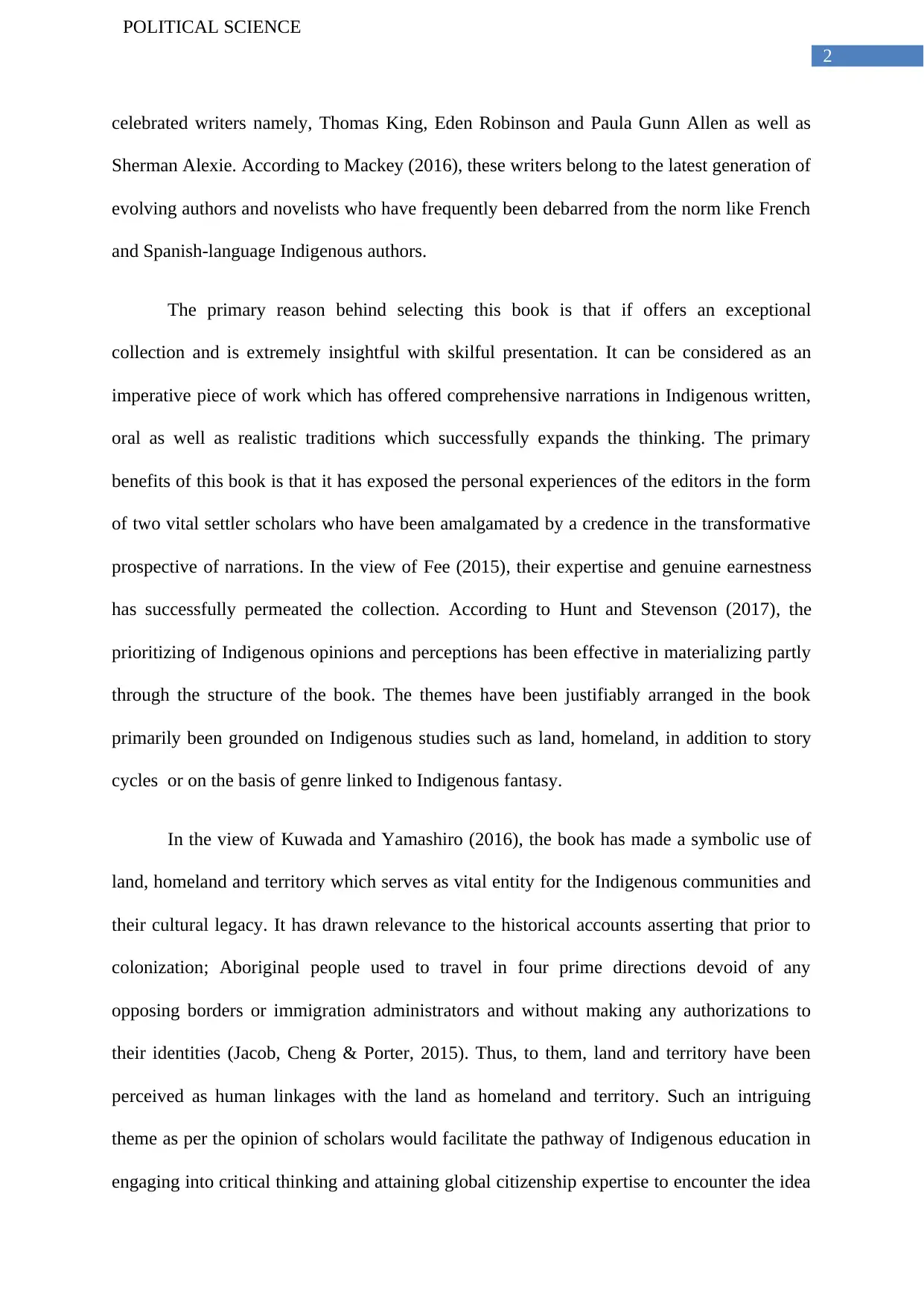
2
POLITICAL SCIENCE
celebrated writers namely, Thomas King, Eden Robinson and Paula Gunn Allen as well as
Sherman Alexie. According to Mackey (2016), these writers belong to the latest generation of
evolving authors and novelists who have frequently been debarred from the norm like French
and Spanish-language Indigenous authors.
The primary reason behind selecting this book is that if offers an exceptional
collection and is extremely insightful with skilful presentation. It can be considered as an
imperative piece of work which has offered comprehensive narrations in Indigenous written,
oral as well as realistic traditions which successfully expands the thinking. The primary
benefits of this book is that it has exposed the personal experiences of the editors in the form
of two vital settler scholars who have been amalgamated by a credence in the transformative
prospective of narrations. In the view of Fee (2015), their expertise and genuine earnestness
has successfully permeated the collection. According to Hunt and Stevenson (2017), the
prioritizing of Indigenous opinions and perceptions has been effective in materializing partly
through the structure of the book. The themes have been justifiably arranged in the book
primarily been grounded on Indigenous studies such as land, homeland, in addition to story
cycles or on the basis of genre linked to Indigenous fantasy.
In the view of Kuwada and Yamashiro (2016), the book has made a symbolic use of
land, homeland and territory which serves as vital entity for the Indigenous communities and
their cultural legacy. It has drawn relevance to the historical accounts asserting that prior to
colonization; Aboriginal people used to travel in four prime directions devoid of any
opposing borders or immigration administrators and without making any authorizations to
their identities (Jacob, Cheng & Porter, 2015). Thus, to them, land and territory have been
perceived as human linkages with the land as homeland and territory. Such an intriguing
theme as per the opinion of scholars would facilitate the pathway of Indigenous education in
engaging into critical thinking and attaining global citizenship expertise to encounter the idea
POLITICAL SCIENCE
celebrated writers namely, Thomas King, Eden Robinson and Paula Gunn Allen as well as
Sherman Alexie. According to Mackey (2016), these writers belong to the latest generation of
evolving authors and novelists who have frequently been debarred from the norm like French
and Spanish-language Indigenous authors.
The primary reason behind selecting this book is that if offers an exceptional
collection and is extremely insightful with skilful presentation. It can be considered as an
imperative piece of work which has offered comprehensive narrations in Indigenous written,
oral as well as realistic traditions which successfully expands the thinking. The primary
benefits of this book is that it has exposed the personal experiences of the editors in the form
of two vital settler scholars who have been amalgamated by a credence in the transformative
prospective of narrations. In the view of Fee (2015), their expertise and genuine earnestness
has successfully permeated the collection. According to Hunt and Stevenson (2017), the
prioritizing of Indigenous opinions and perceptions has been effective in materializing partly
through the structure of the book. The themes have been justifiably arranged in the book
primarily been grounded on Indigenous studies such as land, homeland, in addition to story
cycles or on the basis of genre linked to Indigenous fantasy.
In the view of Kuwada and Yamashiro (2016), the book has made a symbolic use of
land, homeland and territory which serves as vital entity for the Indigenous communities and
their cultural legacy. It has drawn relevance to the historical accounts asserting that prior to
colonization; Aboriginal people used to travel in four prime directions devoid of any
opposing borders or immigration administrators and without making any authorizations to
their identities (Jacob, Cheng & Porter, 2015). Thus, to them, land and territory have been
perceived as human linkages with the land as homeland and territory. Such an intriguing
theme as per the opinion of scholars would facilitate the pathway of Indigenous education in
engaging into critical thinking and attaining global citizenship expertise to encounter the idea
⊘ This is a preview!⊘
Do you want full access?
Subscribe today to unlock all pages.

Trusted by 1+ million students worldwide
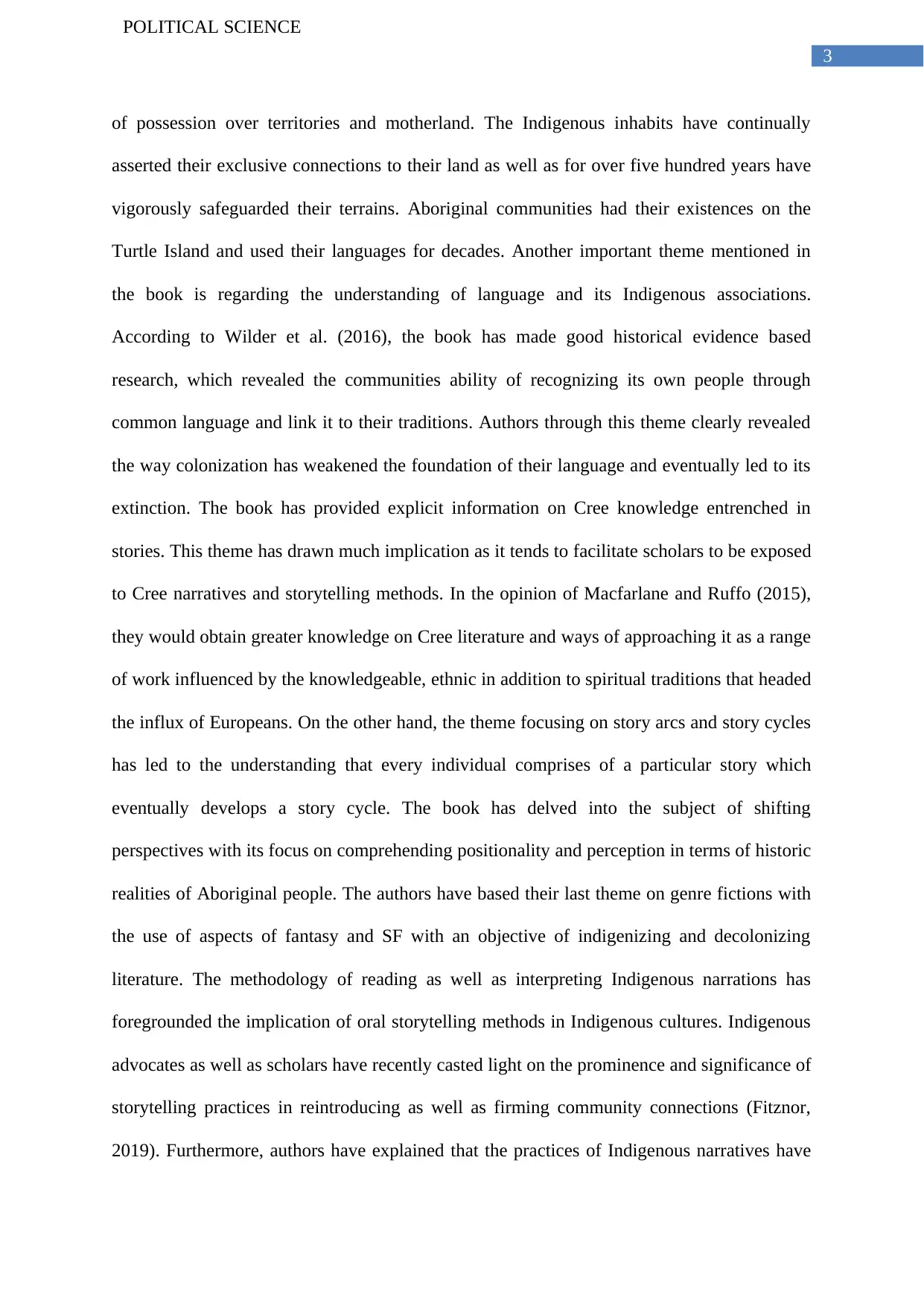
3
POLITICAL SCIENCE
of possession over territories and motherland. The Indigenous inhabits have continually
asserted their exclusive connections to their land as well as for over five hundred years have
vigorously safeguarded their terrains. Aboriginal communities had their existences on the
Turtle Island and used their languages for decades. Another important theme mentioned in
the book is regarding the understanding of language and its Indigenous associations.
According to Wilder et al. (2016), the book has made good historical evidence based
research, which revealed the communities ability of recognizing its own people through
common language and link it to their traditions. Authors through this theme clearly revealed
the way colonization has weakened the foundation of their language and eventually led to its
extinction. The book has provided explicit information on Cree knowledge entrenched in
stories. This theme has drawn much implication as it tends to facilitate scholars to be exposed
to Cree narratives and storytelling methods. In the opinion of Macfarlane and Ruffo (2015),
they would obtain greater knowledge on Cree literature and ways of approaching it as a range
of work influenced by the knowledgeable, ethnic in addition to spiritual traditions that headed
the influx of Europeans. On the other hand, the theme focusing on story arcs and story cycles
has led to the understanding that every individual comprises of a particular story which
eventually develops a story cycle. The book has delved into the subject of shifting
perspectives with its focus on comprehending positionality and perception in terms of historic
realities of Aboriginal people. The authors have based their last theme on genre fictions with
the use of aspects of fantasy and SF with an objective of indigenizing and decolonizing
literature. The methodology of reading as well as interpreting Indigenous narrations has
foregrounded the implication of oral storytelling methods in Indigenous cultures. Indigenous
advocates as well as scholars have recently casted light on the prominence and significance of
storytelling practices in reintroducing as well as firming community connections (Fitznor,
2019). Furthermore, authors have explained that the practices of Indigenous narratives have
POLITICAL SCIENCE
of possession over territories and motherland. The Indigenous inhabits have continually
asserted their exclusive connections to their land as well as for over five hundred years have
vigorously safeguarded their terrains. Aboriginal communities had their existences on the
Turtle Island and used their languages for decades. Another important theme mentioned in
the book is regarding the understanding of language and its Indigenous associations.
According to Wilder et al. (2016), the book has made good historical evidence based
research, which revealed the communities ability of recognizing its own people through
common language and link it to their traditions. Authors through this theme clearly revealed
the way colonization has weakened the foundation of their language and eventually led to its
extinction. The book has provided explicit information on Cree knowledge entrenched in
stories. This theme has drawn much implication as it tends to facilitate scholars to be exposed
to Cree narratives and storytelling methods. In the opinion of Macfarlane and Ruffo (2015),
they would obtain greater knowledge on Cree literature and ways of approaching it as a range
of work influenced by the knowledgeable, ethnic in addition to spiritual traditions that headed
the influx of Europeans. On the other hand, the theme focusing on story arcs and story cycles
has led to the understanding that every individual comprises of a particular story which
eventually develops a story cycle. The book has delved into the subject of shifting
perspectives with its focus on comprehending positionality and perception in terms of historic
realities of Aboriginal people. The authors have based their last theme on genre fictions with
the use of aspects of fantasy and SF with an objective of indigenizing and decolonizing
literature. The methodology of reading as well as interpreting Indigenous narrations has
foregrounded the implication of oral storytelling methods in Indigenous cultures. Indigenous
advocates as well as scholars have recently casted light on the prominence and significance of
storytelling practices in reintroducing as well as firming community connections (Fitznor,
2019). Furthermore, authors have explained that the practices of Indigenous narratives have
Paraphrase This Document
Need a fresh take? Get an instant paraphrase of this document with our AI Paraphraser
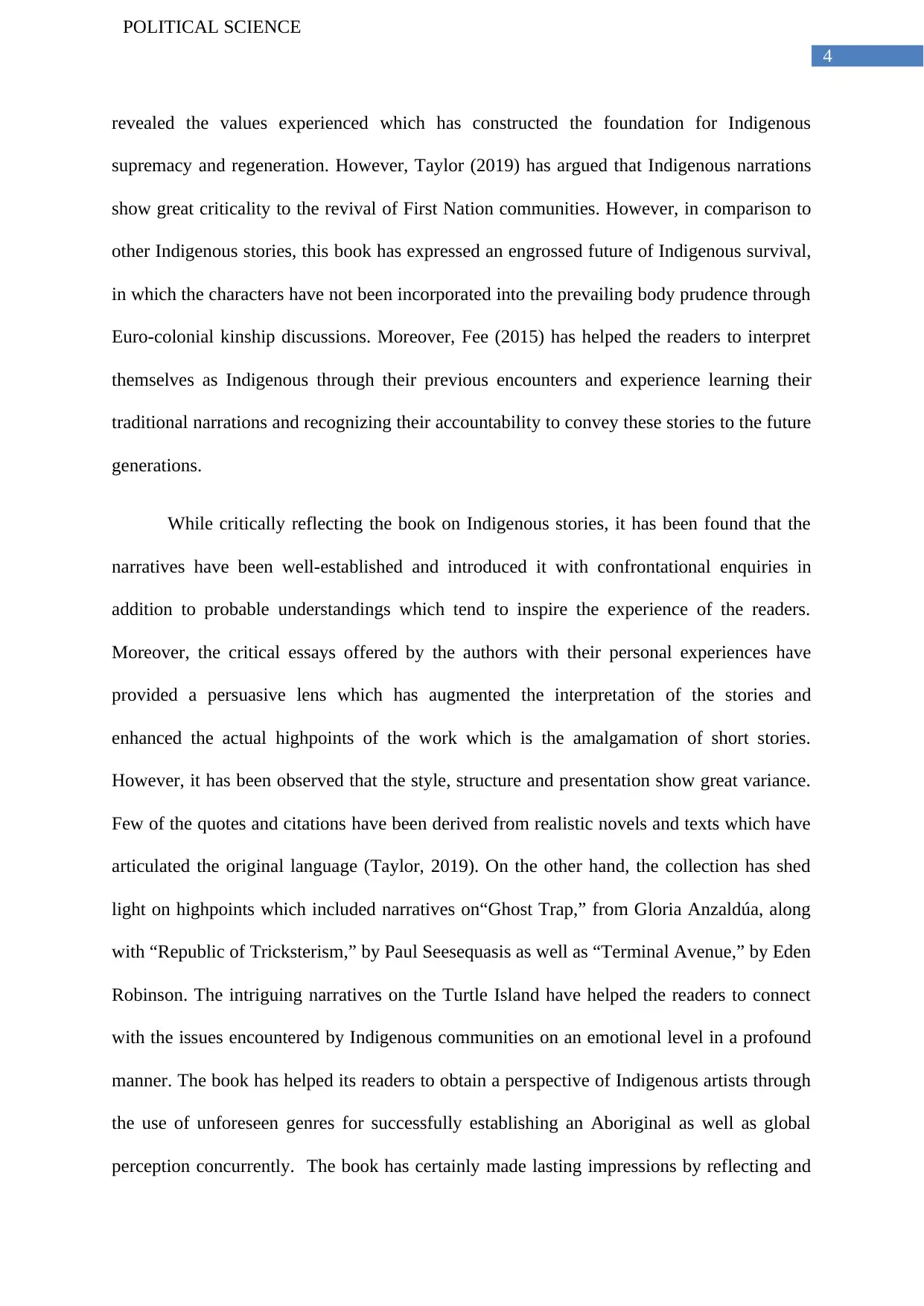
4
POLITICAL SCIENCE
revealed the values experienced which has constructed the foundation for Indigenous
supremacy and regeneration. However, Taylor (2019) has argued that Indigenous narrations
show great criticality to the revival of First Nation communities. However, in comparison to
other Indigenous stories, this book has expressed an engrossed future of Indigenous survival,
in which the characters have not been incorporated into the prevailing body prudence through
Euro-colonial kinship discussions. Moreover, Fee (2015) has helped the readers to interpret
themselves as Indigenous through their previous encounters and experience learning their
traditional narrations and recognizing their accountability to convey these stories to the future
generations.
While critically reflecting the book on Indigenous stories, it has been found that the
narratives have been well-established and introduced it with confrontational enquiries in
addition to probable understandings which tend to inspire the experience of the readers.
Moreover, the critical essays offered by the authors with their personal experiences have
provided a persuasive lens which has augmented the interpretation of the stories and
enhanced the actual highpoints of the work which is the amalgamation of short stories.
However, it has been observed that the style, structure and presentation show great variance.
Few of the quotes and citations have been derived from realistic novels and texts which have
articulated the original language (Taylor, 2019). On the other hand, the collection has shed
light on highpoints which included narratives on“Ghost Trap,” from Gloria Anzaldúa, along
with “Republic of Tricksterism,” by Paul Seesequasis as well as “Terminal Avenue,” by Eden
Robinson. The intriguing narratives on the Turtle Island have helped the readers to connect
with the issues encountered by Indigenous communities on an emotional level in a profound
manner. The book has helped its readers to obtain a perspective of Indigenous artists through
the use of unforeseen genres for successfully establishing an Aboriginal as well as global
perception concurrently. The book has certainly made lasting impressions by reflecting and
POLITICAL SCIENCE
revealed the values experienced which has constructed the foundation for Indigenous
supremacy and regeneration. However, Taylor (2019) has argued that Indigenous narrations
show great criticality to the revival of First Nation communities. However, in comparison to
other Indigenous stories, this book has expressed an engrossed future of Indigenous survival,
in which the characters have not been incorporated into the prevailing body prudence through
Euro-colonial kinship discussions. Moreover, Fee (2015) has helped the readers to interpret
themselves as Indigenous through their previous encounters and experience learning their
traditional narrations and recognizing their accountability to convey these stories to the future
generations.
While critically reflecting the book on Indigenous stories, it has been found that the
narratives have been well-established and introduced it with confrontational enquiries in
addition to probable understandings which tend to inspire the experience of the readers.
Moreover, the critical essays offered by the authors with their personal experiences have
provided a persuasive lens which has augmented the interpretation of the stories and
enhanced the actual highpoints of the work which is the amalgamation of short stories.
However, it has been observed that the style, structure and presentation show great variance.
Few of the quotes and citations have been derived from realistic novels and texts which have
articulated the original language (Taylor, 2019). On the other hand, the collection has shed
light on highpoints which included narratives on“Ghost Trap,” from Gloria Anzaldúa, along
with “Republic of Tricksterism,” by Paul Seesequasis as well as “Terminal Avenue,” by Eden
Robinson. The intriguing narratives on the Turtle Island have helped the readers to connect
with the issues encountered by Indigenous communities on an emotional level in a profound
manner. The book has helped its readers to obtain a perspective of Indigenous artists through
the use of unforeseen genres for successfully establishing an Aboriginal as well as global
perception concurrently. The book has certainly made lasting impressions by reflecting and
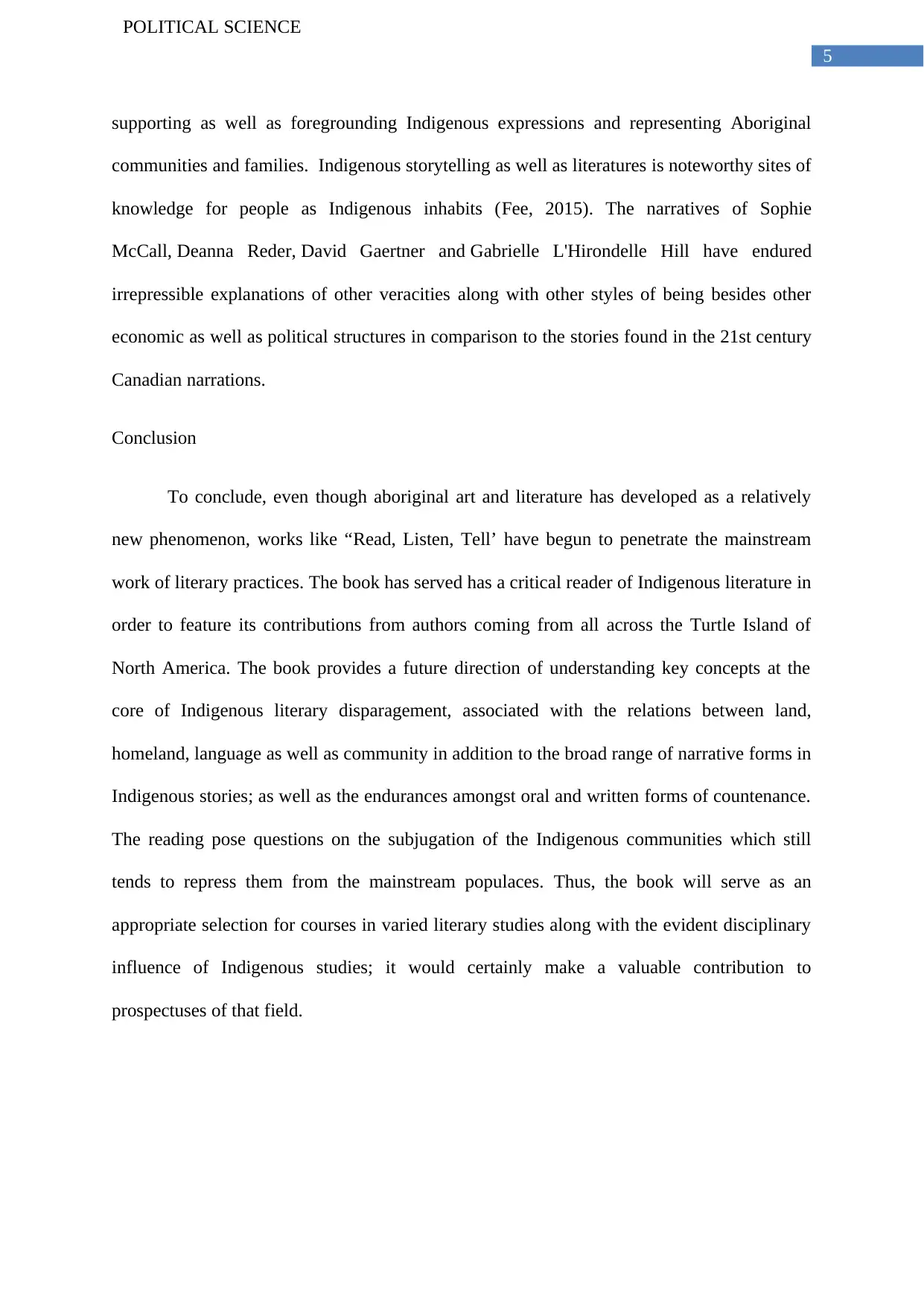
5
POLITICAL SCIENCE
supporting as well as foregrounding Indigenous expressions and representing Aboriginal
communities and families. Indigenous storytelling as well as literatures is noteworthy sites of
knowledge for people as Indigenous inhabits (Fee, 2015). The narratives of Sophie
McCall, Deanna Reder, David Gaertner and Gabrielle L'Hirondelle Hill have endured
irrepressible explanations of other veracities along with other styles of being besides other
economic as well as political structures in comparison to the stories found in the 21st century
Canadian narrations.
Conclusion
To conclude, even though aboriginal art and literature has developed as a relatively
new phenomenon, works like “Read, Listen, Tell’ have begun to penetrate the mainstream
work of literary practices. The book has served has a critical reader of Indigenous literature in
order to feature its contributions from authors coming from all across the Turtle Island of
North America. The book provides a future direction of understanding key concepts at the
core of Indigenous literary disparagement, associated with the relations between land,
homeland, language as well as community in addition to the broad range of narrative forms in
Indigenous stories; as well as the endurances amongst oral and written forms of countenance.
The reading pose questions on the subjugation of the Indigenous communities which still
tends to repress them from the mainstream populaces. Thus, the book will serve as an
appropriate selection for courses in varied literary studies along with the evident disciplinary
influence of Indigenous studies; it would certainly make a valuable contribution to
prospectuses of that field.
POLITICAL SCIENCE
supporting as well as foregrounding Indigenous expressions and representing Aboriginal
communities and families. Indigenous storytelling as well as literatures is noteworthy sites of
knowledge for people as Indigenous inhabits (Fee, 2015). The narratives of Sophie
McCall, Deanna Reder, David Gaertner and Gabrielle L'Hirondelle Hill have endured
irrepressible explanations of other veracities along with other styles of being besides other
economic as well as political structures in comparison to the stories found in the 21st century
Canadian narrations.
Conclusion
To conclude, even though aboriginal art and literature has developed as a relatively
new phenomenon, works like “Read, Listen, Tell’ have begun to penetrate the mainstream
work of literary practices. The book has served has a critical reader of Indigenous literature in
order to feature its contributions from authors coming from all across the Turtle Island of
North America. The book provides a future direction of understanding key concepts at the
core of Indigenous literary disparagement, associated with the relations between land,
homeland, language as well as community in addition to the broad range of narrative forms in
Indigenous stories; as well as the endurances amongst oral and written forms of countenance.
The reading pose questions on the subjugation of the Indigenous communities which still
tends to repress them from the mainstream populaces. Thus, the book will serve as an
appropriate selection for courses in varied literary studies along with the evident disciplinary
influence of Indigenous studies; it would certainly make a valuable contribution to
prospectuses of that field.
⊘ This is a preview!⊘
Do you want full access?
Subscribe today to unlock all pages.

Trusted by 1+ million students worldwide
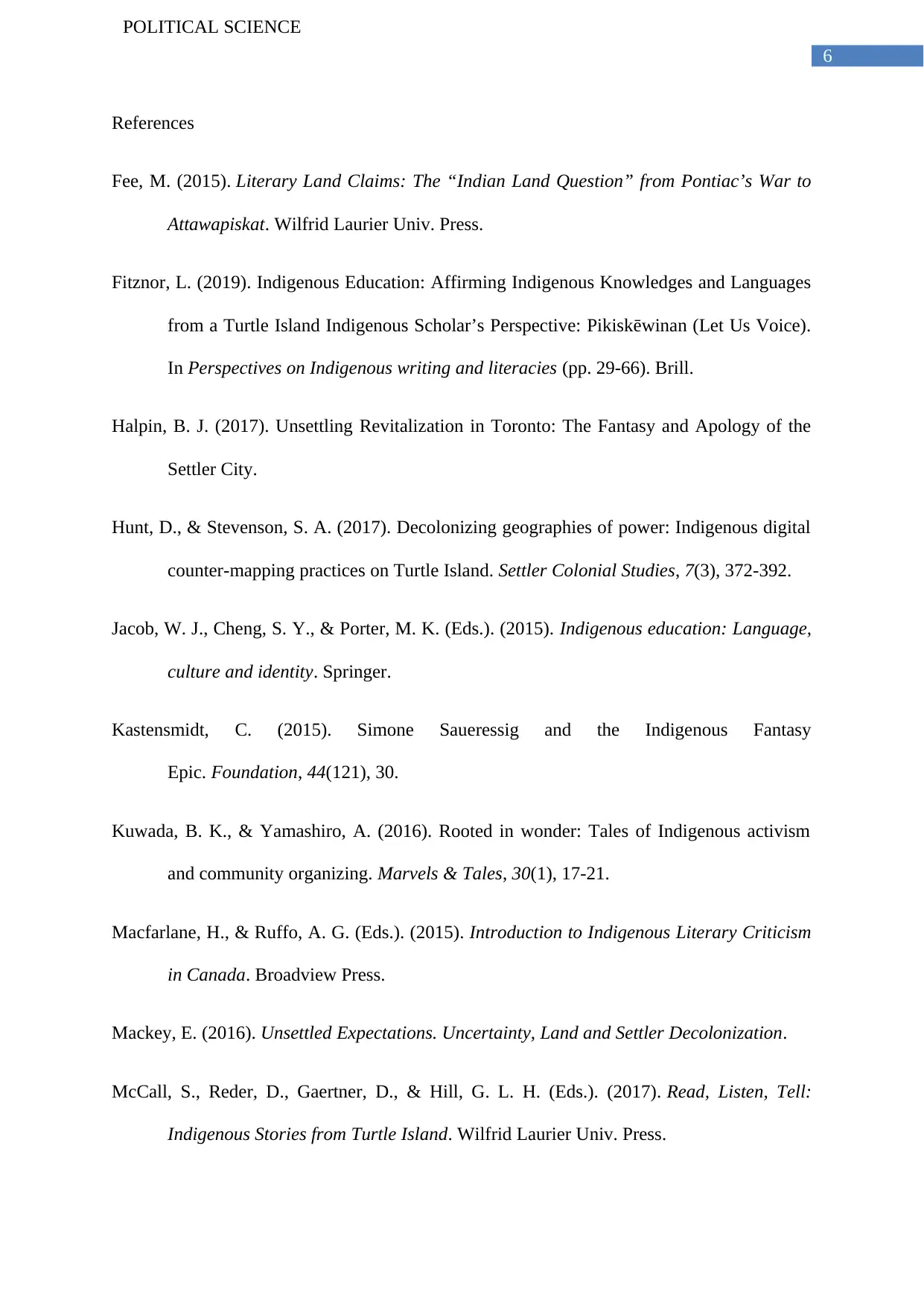
6
POLITICAL SCIENCE
References
Fee, M. (2015). Literary Land Claims: The “Indian Land Question” from Pontiac’s War to
Attawapiskat. Wilfrid Laurier Univ. Press.
Fitznor, L. (2019). Indigenous Education: Affirming Indigenous Knowledges and Languages
from a Turtle Island Indigenous Scholar’s Perspective: Pikiskēwinan (Let Us Voice).
In Perspectives on Indigenous writing and literacies (pp. 29-66). Brill.
Halpin, B. J. (2017). Unsettling Revitalization in Toronto: The Fantasy and Apology of the
Settler City.
Hunt, D., & Stevenson, S. A. (2017). Decolonizing geographies of power: Indigenous digital
counter-mapping practices on Turtle Island. Settler Colonial Studies, 7(3), 372-392.
Jacob, W. J., Cheng, S. Y., & Porter, M. K. (Eds.). (2015). Indigenous education: Language,
culture and identity. Springer.
Kastensmidt, C. (2015). Simone Saueressig and the Indigenous Fantasy
Epic. Foundation, 44(121), 30.
Kuwada, B. K., & Yamashiro, A. (2016). Rooted in wonder: Tales of Indigenous activism
and community organizing. Marvels & Tales, 30(1), 17-21.
Macfarlane, H., & Ruffo, A. G. (Eds.). (2015). Introduction to Indigenous Literary Criticism
in Canada. Broadview Press.
Mackey, E. (2016). Unsettled Expectations. Uncertainty, Land and Settler Decolonization.
McCall, S., Reder, D., Gaertner, D., & Hill, G. L. H. (Eds.). (2017). Read, Listen, Tell:
Indigenous Stories from Turtle Island. Wilfrid Laurier Univ. Press.
POLITICAL SCIENCE
References
Fee, M. (2015). Literary Land Claims: The “Indian Land Question” from Pontiac’s War to
Attawapiskat. Wilfrid Laurier Univ. Press.
Fitznor, L. (2019). Indigenous Education: Affirming Indigenous Knowledges and Languages
from a Turtle Island Indigenous Scholar’s Perspective: Pikiskēwinan (Let Us Voice).
In Perspectives on Indigenous writing and literacies (pp. 29-66). Brill.
Halpin, B. J. (2017). Unsettling Revitalization in Toronto: The Fantasy and Apology of the
Settler City.
Hunt, D., & Stevenson, S. A. (2017). Decolonizing geographies of power: Indigenous digital
counter-mapping practices on Turtle Island. Settler Colonial Studies, 7(3), 372-392.
Jacob, W. J., Cheng, S. Y., & Porter, M. K. (Eds.). (2015). Indigenous education: Language,
culture and identity. Springer.
Kastensmidt, C. (2015). Simone Saueressig and the Indigenous Fantasy
Epic. Foundation, 44(121), 30.
Kuwada, B. K., & Yamashiro, A. (2016). Rooted in wonder: Tales of Indigenous activism
and community organizing. Marvels & Tales, 30(1), 17-21.
Macfarlane, H., & Ruffo, A. G. (Eds.). (2015). Introduction to Indigenous Literary Criticism
in Canada. Broadview Press.
Mackey, E. (2016). Unsettled Expectations. Uncertainty, Land and Settler Decolonization.
McCall, S., Reder, D., Gaertner, D., & Hill, G. L. H. (Eds.). (2017). Read, Listen, Tell:
Indigenous Stories from Turtle Island. Wilfrid Laurier Univ. Press.
Paraphrase This Document
Need a fresh take? Get an instant paraphrase of this document with our AI Paraphraser
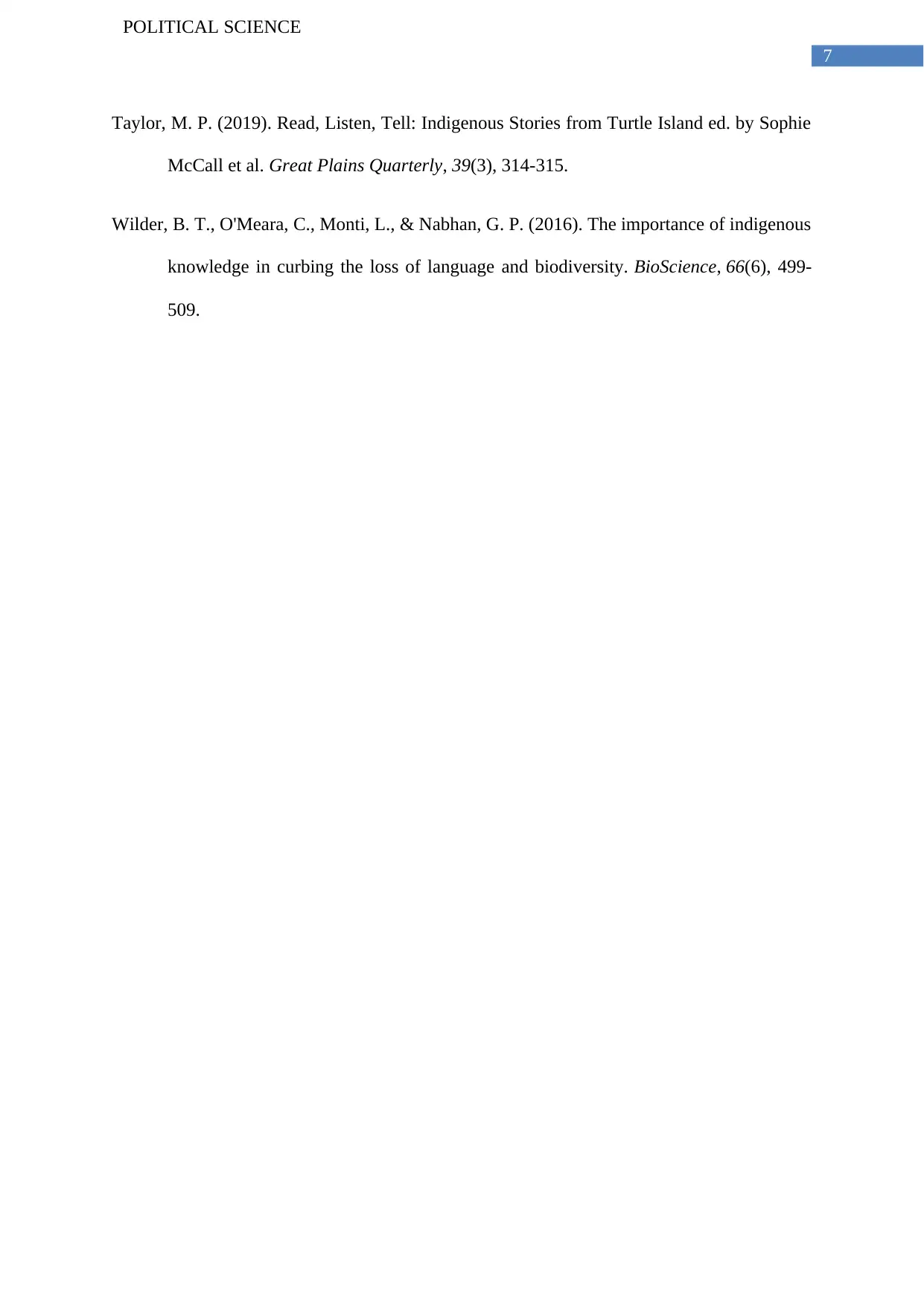
7
POLITICAL SCIENCE
Taylor, M. P. (2019). Read, Listen, Tell: Indigenous Stories from Turtle Island ed. by Sophie
McCall et al. Great Plains Quarterly, 39(3), 314-315.
Wilder, B. T., O'Meara, C., Monti, L., & Nabhan, G. P. (2016). The importance of indigenous
knowledge in curbing the loss of language and biodiversity. BioScience, 66(6), 499-
509.
POLITICAL SCIENCE
Taylor, M. P. (2019). Read, Listen, Tell: Indigenous Stories from Turtle Island ed. by Sophie
McCall et al. Great Plains Quarterly, 39(3), 314-315.
Wilder, B. T., O'Meara, C., Monti, L., & Nabhan, G. P. (2016). The importance of indigenous
knowledge in curbing the loss of language and biodiversity. BioScience, 66(6), 499-
509.
1 out of 8
Your All-in-One AI-Powered Toolkit for Academic Success.
+13062052269
info@desklib.com
Available 24*7 on WhatsApp / Email
![[object Object]](/_next/static/media/star-bottom.7253800d.svg)
Unlock your academic potential
Copyright © 2020–2025 A2Z Services. All Rights Reserved. Developed and managed by ZUCOL.
